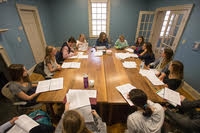You have /5 articles left.
Sign up for a free account or log in.

U of Virginia students in a seminar
Courtesy of John Anthony Carfagno
On many campuses, students can complete general education without understanding why they faced the requirements they did. But two large public universities are attempting to change this. The State University of New York at Buffalo and the University of Virginia are undertaking expansive general-education reforms in the hopes of providing students across disciplines a shared intellectual experience.
This fall, the University at Buffalo will unveil the UB Curriculum, a revamped general-education program that seeks to transmit essential knowledge and skills in the liberal arts. Under the new program, students will be required to take courses in four categories: communication literacy, math and quantitative reasoning, scientific literacy and inquiry and diversity learning.
Similarly, UVA will pilot a new curriculum in the next two to three years that will introduce new core requirements for all students. The core requirements will fall under the three categories of engagements, literacies and disciplines.
Both of these approaches will replace systems in which students could choose among many categories -- systems that didn't necessarily foster the type of cohesive learning that faculty members want to see.
While these new categories may sound like mere buzzwords, they in fact reflect a profound shift toward viewing general education as a means of offering students a meaningful liberal arts experience. This shift is not occurring solely at large public universities like UB and UVA. A survey this year by the Association of American Colleges and Universities found that general-education redesign has grown as a priority on college campuses since 2008, with two in three academic officers reporting that general education is receiving greater attention at their institution.
“A majority of our members are relooking at their general-education programs, and that’s been true for a while,” said Debra Humphreys, senior vice president for academic planning and public engagement at the AAC&U.
The general-education redesigns at the University at Buffalo and UVA both represent attempts to reconcile the tension between providing students with specific skill sets and broad knowledge, Humphreys said. “What you’re seeing in both of these programs is this new, emerging hybrid model of general education, in which there’s an attempt to balance the need for high-level skill development with the need to still provide a breadth of knowledge areas extending beyond majors,” she said.
‘A Deep Commitment’
Over the last 20 years, students at UB have technically been required to take courses in 10 categories -- such as basic communication, mathematics and Western civilization -- as well as an 11th course outside of their major. But when administrators looked into it, they found that only 20 percent of students were meeting this requirement, since many were receiving waivers or exemptions, said Andrew Stott, vice provost and dean of undergraduate education at UB.
“It was actually quite fragmented,” Stott said. “There wasn’t a shared experience around general education. If you were a business major, you would have different requirements than an engineer. So there was some feeling that it wasn’t equitable to all students, and different people had different requirements.”
When Charles Zukoski became provost at the University at Buffalo in 2012, he sought to make general-education redesign a key priority, he said. “I felt a deep commitment to revising gen ed,” Zukoski said. “It is such a major transformation of the curriculum touching every undergraduate that it requires the chief academic officer saying, ‘We value this change.’”
Shortly after assuming his post, Zukoski charged committees with reviewing a 2009 report on general education at UB and making recommendations. The committees issued their recommendations in 2013, and the Faculty Senate approved them in January 2014.
Under the recommendations, students will be required to take courses in the four foundations of communication literacy, math and qualitative reasoning, scientific literature and inquiry, and diversity learning. Stott highlighted the diversity-learning requirement -- which can be fulfilled through courses on topics such as the civil rights movement and slavery in America -- as an opportunity to broaden students’ cultural awareness. “We thought it was important that our students leave with some cultural competency training and the way the society we live in came to be,” he said.
Freshmen and first-year transfer students will be required to enroll in a small first-year seminar taught by a faculty member, Stott said. These seminars will help provide a smooth transition for transfer students, who make up about 40 percent of the student body, he said. In addition, upperclassmen will be required to enroll in a capstone that lets them produce a written reflection on their academic experiences, he said. This reflects a trend pushed by the AAC&U and others of ensuring that general education continues throughout an undergraduate education, not just at the beginning of one.
The first-year seminars are “designed to get the students thinking and talking in the presence of a faculty member right from the moment they step on campus,” Zukoski said. “This is a very large deal for a large state university to be able to do this.”
In its survey this year, the AAC&U found that approximately 52 percent of member institutions offer first-year seminars, Humphreys said. But some institutions make these first-year seminars optional, rather than a mandatory part of general education, she said. “Increasingly within the last few years, a lot of forward-thinking institutions have thought about whether there are some they really have to make required,” she said.
To help integrate their learning in different disciplines, students will be asked to choose a “thematic pathway” and enroll in three courses joined by a common theme, Stott said. Examples of thematic pathways include environment, health, innovation and justice. Students will also be required to complete a “global pathway” by studying abroad or taking a course on language or global reflections.
A new online platform, called the Pathfinder Tool, which was built at UB, will allow students to select these pathway courses as well as others. “A lot of schools are very smartly using online tools for student success-oriented advising,” Humphreys said. “In my experience, fewer are using online platforms to do intensive gen-ed advising. But I think it has potential.”
In Search of Coherence
Five years ago, several UVA faculty members created an informal committee to discuss general education. They began by pinpointing a problem: the stratification of the curriculum.
“We recognized that our students shared an extracurricular life, but they didn’t share a curriculum,” said Chad Wellmon, associate professor of German studies and chair of the curriculum-planning committee at UVA. “Students are very active in different clubs. But when it came to academics, it was scattered and incoherent. What coherence there was to their lives happened outside of the classroom.”
In essence, the committee found that UVA needed to replace its “cafeteria-style” approach, which asked students to meet several distribution requirements without encouraging thoughtful integration of different disciplines, Wellmon said.
After a great deal of planning, the committee presented its proposal for general-education redesign May 4 to the faculty of the College of Arts and Sciences. The proposal passed following an 84 percent majority vote, with 210 faculty members in favor and 41 against.
Some faculty members who voted against the proposal saw the situation as a zero-sum game, in which devoting resources to general education would detract from resources for individual departments, Wellmon said. Others had reservations about altering such a time-worn curriculum, he said. “UVA’s curriculum hasn’t been updated in at least 40 years, and in a lot of ways substantively, in at least 70 years,” he said.
“Forty years is a long time,” Humphreys said. “We often get schools at our [Institute on General Education and Assessment] who are looking at programs that have been around for 10 or 20 years.”
UVA will enact the proposed general-education redesign as a pilot program for the next two or three years. In 2018, the faculty of the College of Arts and Sciences will vote on whether to continue, modify or abandon the pilot program.
The pilot program centers on core requirements in the three categories of engagements, literacies and disciplines. The literacies category requires at least four semesters of a foreign language, at least two semesters of writing and at least two courses or six credits of quantification, computation and data analysis, Wellmon said. (Note: This paragraph has been updated from an earlier version to clarify the requirements.)
Another key component of the pilot program is the College Fellows program, which will allow designated faculty members to design new first-year courses that fall within the engagement category. This category is based on four ways of engaging with the world: aesthetic engagement, empirical engagement, ethical engagement and engaging difference, Wellmon said.
“At the heart of the new curriculum pilot is a signature set of engagement courses designed to help first-year students engage the world from the moment they arrive at UVA,” wrote Ian Baucom, college dean at the University of Virginia, in an email. “The new faculty College Fellows … will work together to take responsibility for designing and teaching these first-year courses and connecting the curriculum to the broader aims of general education, particularly equipping students for lives of meaningful vocation and engaged citizenship.”
The application for the College Fellows program is due June 29, and faculty interest has been high so far, Wellmon said. Eight to 12 faculty members will be selected from the applicant pool, and they will spend the next year crafting their courses, he said.
In fall 2017, the faculty members will offer these courses to 500 students who elect to participate in the pilot program. In fall 2018, that number will double to 1,000 participating students.
“One of the biggest challenges we face is that faculty gain prestige and publication through an international community,” Wellmon said. “That has obvious negative consequences for undergraduate education. The College Fellows program is an attempt to have a faculty whose first commitment would be to designing and cultivating general education.”




